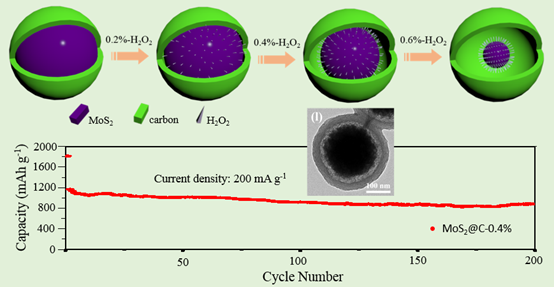As an electrode material for lithium-ion batteries (LIBs), MoS2has attracted much attention because of its high capacity and low cost. However, the rational design of a novel electrode structure with a high capacity, fast charge/discharge rate, and long cycling lifetime remains a great challenge. Herein, a environmentally friendly etching strategy is reported for the construction of monodisperse, inner void-controlled yolk–shell MoS2@carbon microspheres. The resulting anode reveals an initial discharge capacity up to 1813 mAh g-1, a high reversible capacity (1016 mAh g-1), excellent cycling stability (200 cycles), and superior rate performance. Such microspheres consist of nanosized MoS2 yolks (~280 nm), porous carbon shells (~25 nm) and wellcontrolled internal voids in between, opening a new pathway for the optimization of the electrochemical properties of MoS2-based anodes without sacrificing their capacity. In addition, this etching strategy offers a new method for the development of functional, hollow MoS2-based composites.
This work has been published on Chemistry-A European Journal, see details:
Yunmei Pan, Jiajia Zhang, and Hongbin Lu*, Uniform Yolk-shell MoS2@carbon Microsphere Anodes for High Performance Lithium-Ion Batteries, Chemistry – A European Journal, 2017, DOI: 10.1002/chem.201701691
